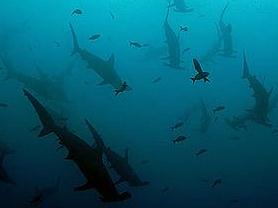 根據世界自然保育聯盟(IUCN)物種生存委員會鯊魚專家小組最新的調查研究顯示,外海中有1/3的鯊魚瀕臨滅絕,而且還幾乎完全不受任何保護。f
根據世界自然保育聯盟(IUCN)物種生存委員會鯊魚專家小組最新的調查研究顯示,外海中有1/3的鯊魚瀕臨滅絕,而且還幾乎完全不受任何保護。f
這是首度對全球64種外海鯊魚和魟魚的保育狀況所做的研究。結果顯示,其中32%的魚類主要因爲過度捕撈而遭受威脅,52%從公海捕獲的鯊魚物種面臨威脅。
世界自然保育聯盟鯊魚專家小組副主席,和鯊魚聯盟政策主任福特漢(Sonja Fordham)表示,「我們的報告中記錄了這些物種嚴重過度捕撈的情況。同時也明確説明了立即展開全球性行動的必要。」
研究發現在大多數情況下,外海海域鯊魚捕獲量是不受管制或不可持續的。24%經過調查的物種被列為近乎受到威脅,另外的25%則因資訊不夠而無法加以評估。
許多外海的鯊魚是由遠洋捕撈鮪魚和劍旗魚漁船作業時所捕獲的。一度被認為只是附帶的魚獲,但隨著市場對鯊魚肉的喜好,和用於烹調亞洲的佳肴魚翅湯,而備受歡迎的高價值魚鰭,這些物種越來越常成爲捕撈的對象。
源于這類需求,鯊魚身上的魚鰭往往被切斷後,身體和其他部位則被投擲回海裏。而這個過程稱為割鰭棄身(finning)。
 鯊魚專家表示,獵鰭禁令已在大多數的國際水域中實施,但寬鬆的執法標準有損法令的效率。
鯊魚專家表示,獵鰭禁令已在大多數的國際水域中實施,但寬鬆的執法標準有損法令的效率。
由於鯊魚成長許多年才能達到成熟階段,孕育的後代也相對較少,因此過度捕撈對它們的影響特別明顯。
保育聯盟的鯊魚專家小組,呼籲各國政府在諮詢科學例證和採取謹慎處理的態度基礎上,制定鯊魚和魟魚的捕撈限額。
鼠鯊在全球各地被歸類為脆弱的物種。但在東北大西洋被認為是重度瀕危。在西北大西洋則列為瀕危物種。
保育聯盟專家將巨雙髻鯊、雙髻鯊、鯊魚、巨型魔鬼魚等歸類為全球瀕危物種。
平雙髻鯊、大白鯊、姥鯊、遠洋白鰭鯊、鯊魚等都被歸類為全球脆弱到滅絕物種。
水鯊是世界上最多,也是遠洋捕鯊最嚴重的一種鯊魚,被列為近乎脆弱物種。
保育聯盟鯊魚專家小組是由來自90個國家, 180名專家所組成的一個網絡團體。他們參與研究、漁業管理、海洋保護或鯊魚及其近親(魟魚、灰鰩、銀鮫)政策的制定和實施。該小組負責評估1千多種物種的保育狀況。
One-third of open ocean sharks are threatened with extinction yet are virtually unprotected, according to new research by the fShark Specialist Group of the IUCN's Species Survival Commission.
The first study to determine the global conservation status of 64 species of open ocean sharks and rays reveals that 32 percent are threatened, primarily due to overfishing, and 52 percent of the shark species taken in high-seas fisheries are threatened.
"Our report documents serious overfishing of these species, in national and international waters, and demonstrates a clear need for immediate action on a global scale," said Sonja Fordham, deputy chair of the IUCN Shark Specialist Group and policy director for the Shark Alliance.
In most cases, open ocean shark catches are unregulated or unsustainable, the study finds. Twenty-four percent of the species examined are categorized as Near Threatened, while information is insufficient to assess another 25 percent.
Many open ocean sharks are taken in the high seas tuna and swordfish fisheries. Once considered only incidental bycatch, these species are increasingly targeted due to new markets for shark meat and high demand for their valuable fins, used in the Asian delicacy shark fin soup.
To source this demand, the fins are often cut off sharks and the rest of the body is thrown back in the water, a process known as finning.
Finning bans have been adopted for most international waters, but lenient enforcement standards hamper their effectiveness, the shark specialists say.
Sharks are particularly sensitive to overfishing due to their tendency to take many years to mature and have relatively few young.
The IUCN Shark Specialist Group calls on governments to set catch limits for sharks and rays based on scientific advice and the precautionary approach.
Porbeagle sharks, Lamna nasus, are classified as globally Vulnerable, but are considered Critically Endangered in the Northeast Atlantic and and Endangered in the Northwest Atlantic.
IUCN experts classify Great Hammerhead, Sphyrna mokarran, and Scalloped Hammerhead, Sphyrna lewini, sharks, as well as Giant Devil Rays, Mobula mobular, as globally Endangered.
Smooth Hammerheads, Sphyrna zygaena, Great White, Carcharodon carcharias, Basking, Cetorhinus maximus, and Oceanic Whitetip, Carcharhinus longimanus, sharks are classed as globally Vulnerable to extinction.
The Blue Shark, Prionace glauca, the world's most abundant and heavily fished open ocean shark, is classified as Near Threatened.
The IUCN Shark Specialist Group is a network of 180 experts from 90 countries who are involved in research, fisheries management, marine conservation or policy development and implementation for sharks and their relatives; the skates, rays and chimaeras. The group is responsible for assessing the conservation status of the more than 1,000 species.





